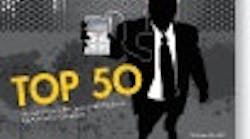There seems to be some confusion about what the rules are that Larry O'Brien and I are playing under for the Control/ARC Top Fifty Automation Companies article we co-author every December.
So, I thought we'd go over the groundrules once more, for effect:1. We use the last complete fiscal year data. This means that for 2008, we used the FY2007 data for all companies. This means that we are working from the same slate, and the numbers are all normalized to mean the same thing. We would like to use newer numbers, but since many of the companies in the list are notorious for not responding to our requests for assistance, we have decided to use numbers from annual reports we CAN get, and supplementary data based on those numbers.
When we have a rapid financial turnaround, as we are going through now, the numbers will not reflect the last quarter, or the last two quarters or the last three quarters' results. This is just impossible to do, and keep the playing field level.
However, companies that appear to be fiscally sound in January of 2008 (as reported by the global financial media and industry analysts) are likely to continue to be fiscally sound in January of 2009.
2. We consider all automation, not just process. For years, we tried to separate out only those revenues identifiable as coming from process automation... and we finally decided that it was flat out impossible. In part, it is because many companies won't break out the numbers that way. Also, frankly, convergence is making it harder and harder for the companies themselves to break out those numbers. If Company R sells something to enduser PG, is is process, is it discrete, is it integration, or is it a melange of all of the above? Nobody can tell, so we decided to go with "automation."
3. What's in, what's out: Every year since Larry and I started doing this in the new format, I've opened the article with a clear definition of what we count, and what we don't count. We've changed it slightly year over year, but we haven't made massive changes. Here again is what's in, and what's not.
Here’s what we’re including in our definition of the 50 largest companies:
- Process automation systems and related hardware software and services
- PLC business, as well as related hardware, software, services, I/O and bundled HMI
- Other control hardware components, such as third-party I/O, signal conditioners, intrinsic safety barriers, networking hardware, unit controllers and single and multiloop controllers
- Process safety systems
- SCADA systems for oil and gas, water and wastewater treatment, and power distribution
- AC drives
- General motion control systems
- Computer numerical control (CNC) systems
- Process field instrumentation, such as temperature and pressure transmitters, flowmeters, level transmitters and associated switches
- Analytical equipment, including process electrochemical, all types of infrared technology, gas chromatographs for industrial manufacturing and related products
- Control valves, actuators and positioners
- Discrete sensors and actuators
- All kinds of automation-related software, from advanced process control, simulation and optimization to third-party HMI, plant asset management, production management (MES), ERP integration packages from the major automation suppliers and similar software
- All other automation-related services provided by the automation suppliers
- Condition-monitoring equipment and systems
- Ancillary systems, such as burner management systems, QCSs for pulp and paper, etc.
What we’re not including are:
- Pumps and motors
- Robotics
- Material-handling systems
- Supply chain management software
- Building automation systems
- Fire and security systems
- Processing equipment such as mixers, vessels, heaters, etc., as well as process design licenses from suppliers that have engineering divisions
- Electrical equipment, such as low-voltage switchgear, etc.
Them's the rules, folks. You are all welcome to comment to us on why you think we're wrong, or how you think we could do it better. But it would be nice if you brought us specific suggestions. It would also be nice, if you are a company on that list, that you help us get the correct numbers. That way you are entirely entitled to complain if we get them wrong.





